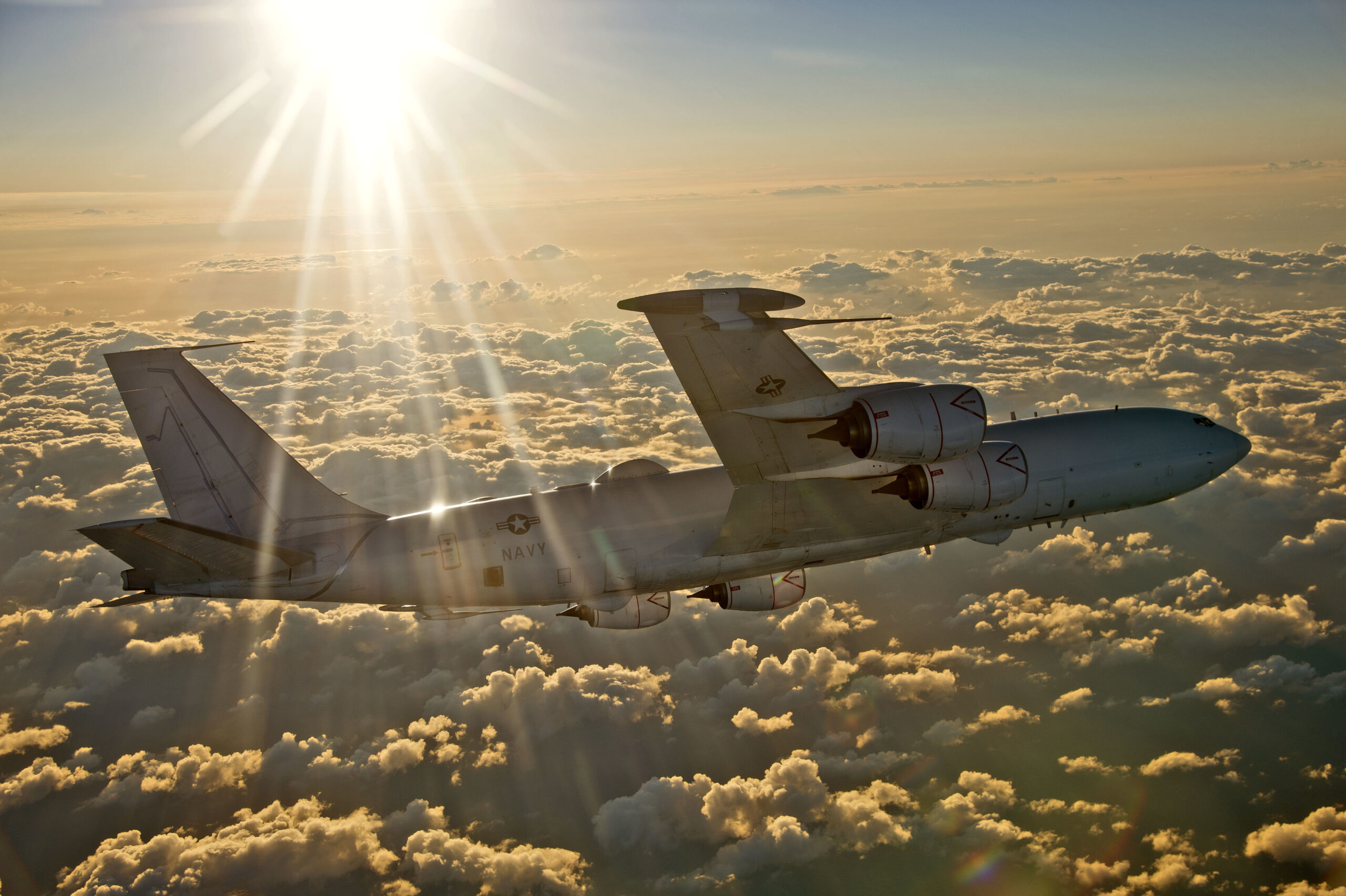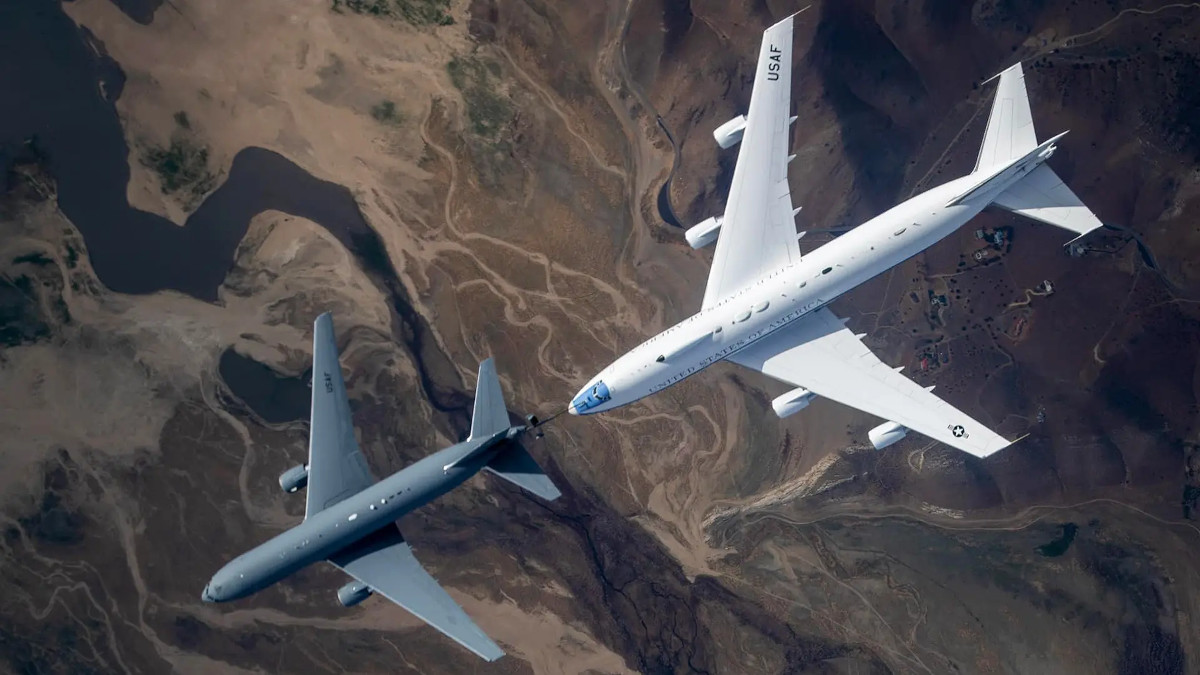Industry officials have confirmed that the future E-XX aircraft, which will provide airborne strategic command and control support for America’s ballistic missile submarines, will not also have the ability to maintain communications with the Air Force’s intercontinental ballistic missile (ICBM) and bomber units.
While we knew that the C-130J-based aircraft — which will replace the current fleet of Navy E-6B Mercury ‘Doomsday Planes’ — would initially perform only the TACAMO, or Take Charge And Move Out ballistic submarine communications mission, the latest development indicates that the new Hercules-based platform will be limited to this function long-term, too. This leaves major questions about the future of the Air Force’s needs for a survivable airborne communications and command post aircraft to fulfill the ‘Looking Glass’ ICBM communications role. Currently, the E-6Bs provide both capabilities and a secondary emergency command post and communications role for domestic contingencies.

This disclosure came yesterday at the Navy League’s Sea Air Space symposium outside Washington, D.C., during an event announcing one of the teams of subcontractors competing to provide the E-XX. The team led by Northrop Grumman will include Lockheed Martin’s Skunk Works, Raytheon, Crescent Systems, and Long Wave.
“We are very excited about the opportunity that we have today to announce the superior team that we have put together to pursue, capture, and deliver the United States Navy’s E-XX TACAMO weapon system,” Jane Bishop, vice president and general manager of Northrop’s Global Surveillance Division told media yesterday. “The E-XX TACAMO aircraft will be based upon the C-130J-30 platform, and it will provide survivable, reliable, and endurable command, control, and communications.”

“Our extensive experience integrating aircraft and mission systems, combined with our expertise in creating operationally ready solutions in support of the nuclear enterprise, makes Northrop Grumman the optimal partner to deliver the Navy’s E-XX TACAMO weapon system,” said Janice Zilch, vice president of Northrop’s Multi-Domain Command and Control Programs, in a company media release. “As we’ve demonstrated with the Navy’s E-2 programs, we have been a longtime partner in helping the Navy meet its operational requirements. We will bring this expertise in helping the Navy deliver the E-XX TACAMO on time and optimized for this strategically important mission.”
Meanwhile, at the Sea Air Space symposium, Jane Bishop reiterated that the E-XX aircraft’s mission is to communicate with “ballistic submarines that are … capable of delivering nuclear weapons.”
That, however, is just one of several missions flown by today’s E-6B.

“The Navy determined the best approach was to focus specifically on the TACAMO mission,” explained Henry Cyr, director of Northrop’s Multi-Domain Command & Control Capture Programs.
At least part of this decision seems to have been based on the Navy opting for the C-130J platform following its Analysis of Alternatives for an E-6B replacement.
“The Analysis of Alternatives chose the C-130 … because again it is right-sized for the new mission equipment,” Cyr added. “Also from flight characteristics, it actually performs a little bit better, quite honestly, because the C-130 is a high-wing aircraft [so] the aerodynamics provide a better efficiency, more capability.”

Indeed, last year, Christopher Hurd, public affairs officer for the Airborne Strategic Command, Control and Communications Program Office (PMA-271) at the Naval Air Warfare Center Aircraft Division, confirmed to The War Zone that the Analysis of Alternatives “indicated that a four-engine, domestically produced small aircraft is optimal for the TACAMO recapitalization.” That decision effectively ruled out any other platform options.
As we have noted in the past, the choice of the turboprop C-130J to replace the four-jet E-6B was still surprising, in some ways. Certainly, the cargo-focused fuselage provides considerable capacity for avionics and equipment, but a derivative of the twin-engine P-8 Poseidon maritime patrol aircraft, or even of the KC-46 Pegasus tanker seemed more likely.
As well as the Navy’s stipulation that the E-XX be based on a C-130J airframe, the service has also already selected Collins Aerospace to provide the very low frequency (VLF) communication system for the aircraft.
The VLF system, which is based on a trailing antenna cable, is central to the TACAMO mission. It allows for communications with submerged submarines even in a nuclear combat environment. Doing this involves the flight crew putting the aircraft into a series of very steep and tight banking turns at slow speed, to ensure that the antenna is as close to vertical as possible, for maximum transmission effectiveness.
Outside of Lockheed’s C-130J platform and the Collins Aerospace VLF system, the Navy is yet to decide on which industry team will provide the rest of the equipment required for the E-XX. As well as the Northrop-led team announced yesterday, Collins Aerospace will also be competing for the contract. According to Breaking Defense, Collins will be teaming up with Sierra Nevada Corporation.
The timeline for the program is fairly tight, reflecting the Navy’s requirement that the transition from the E-6B to the E-XX be made fairly quickly and, as Northrop’s Henry Cyr observed, “it’s not intended to be a new technology demonstration. It is intended to take existing capability that can be fielded in the near term as defined by the budget document, and then quickly transition.”
Cyr also provided some interesting details on the scope of the E-XX program and how it will compare with the technologies currently in use on the E-6B.
“I think, as we all know, you’re not going to simply take things out of the original airplane and move them over for a variety of reasons,” Cyr observed. “Technology has advanced [such that] the radios are smaller; the computing systems are smaller and faster and more capable. So we will bring new systems in that will improve the performance of the system overall, but fundamentally, the TACAMO mission is enduring and remains the same.”

Cyr also pointed out that these same advances in technology will enable the TACAMO mission equipment to be installed into what’s a smaller aircraft overall, although reducing the scope of the E-6B’s broader mission portfolio plays a role here, too.
“What we will bring is a system that is inherently cheap,” Cyr continued. “Within that C-130 there’s a size, weight, power consideration, and so, as we migrate this into what is a smaller aircraft, which is a smaller mission set, we will use that as an opportunity to address some of those size, weight, and power concerns today.”
As to one of the key reasons that the TACAMO mission equipment in the E-6B won’t simply be “moving over, lock stock and barrel” to the C-130J-based platform, Cyr pointed to cybersecurity requirements that “now are far more significant than when that aircraft [the E-6B] was originally built.” Indeed, the “cybersecurity requirements alone will make this a new system,” Cyr added.
Replacing the E-6B is becoming an increasingly urgent priority. While these aircraft are among the youngest 707 derivatives, they have been worked heavily over more than three decades, and they undergo some unique stresses and strains, including the repeated turns that are used to deploy the VLF antennas. In the meantime, continued upgrades and, from next year, a dedicated crew trainer, will help extend the potential lifespan of this vital national security asset.
A draft request for proposals for E-XX is expected in the next few weeks, after which the Northrop and Collins teams will work out how to best meet the Navy’s requirements, before the research, development, test, and engineering phase is launched, planned for 2024 or 2025.
The Navy’s 2024 Fiscal Year budget request calls for procurement of the E-XX to begin in 2027, with three engineering and manufacturing development aircraft and six production aircraft the following year. Contract award is specified for the first quarter of fiscal 25 — somewhere between October and December of 2024. Ultimately, Northrop expects the final TACAMO fleet to be bigger than just those nine aircraft, although it’s unclear if the 16-strong E-6B fleet will be replaced on a one-for-one basis.
But whatever choice the Navy makes in terms of the mission avionics for the E-XX, it’s a highly significant change that, in contrast to the E-6B that it’s replacing, the new aircraft will be dedicated to the TACAMO mission. That leaves the U.S. Air Force’s Airborne Command Post (ABNCP) mission, which involves maintaining communications with ICBM and bomber units, in limbo.
Essentially, the Navy is turning back the clock, to when the TACAMO mission was flown by an earlier Hercules variant, the Cold War-era EC-130Q.

Back when the Navy operated the EC-130Q as its first-generation TACAMO platform, the Air Force used the EC-135 Looking Glass to fulfill its ballistic missile support mission. It was only with the arrival of the E-6B that the two strategic communications roles were consolidated.

It remains to be seen, therefore, what the Air Force will do for its side of the mission once the E-6B is finally retired. Essentially, it will have to resurrect the Looking Glass mission, where one option might be to return it to the Survivable Airborne Operations Center, or SAOC, which is being developed primarily as a replacement for the service’s fleet of E-4B Nightwatch aircraft, also known as National Airborne Operations Centers (NAOC).

At this point, it seems the SAOC is primarily envisaged as an E-4B successor. It is expected to be a 747-based platform, but with only four E-4Bs currently operated, more of these highly expensive platforms would be required if the same type were to cover the ABNCP mission, too. It’s possible that this mission set could look very different altogether, as well, in which a survivable airborne command and control aircraft doesn’t play the same role as it once did.
The War Zone has reached out to the U.S. Strategic Command for further clarification, but with the Navy already having made its decision to drop the Air Force side of the airborne command and control mission, the ball is firmly in the court of the flying branch it works out how to field its own capability to supersede the E-6B.
Contact the author: thomas@thedrive.com
